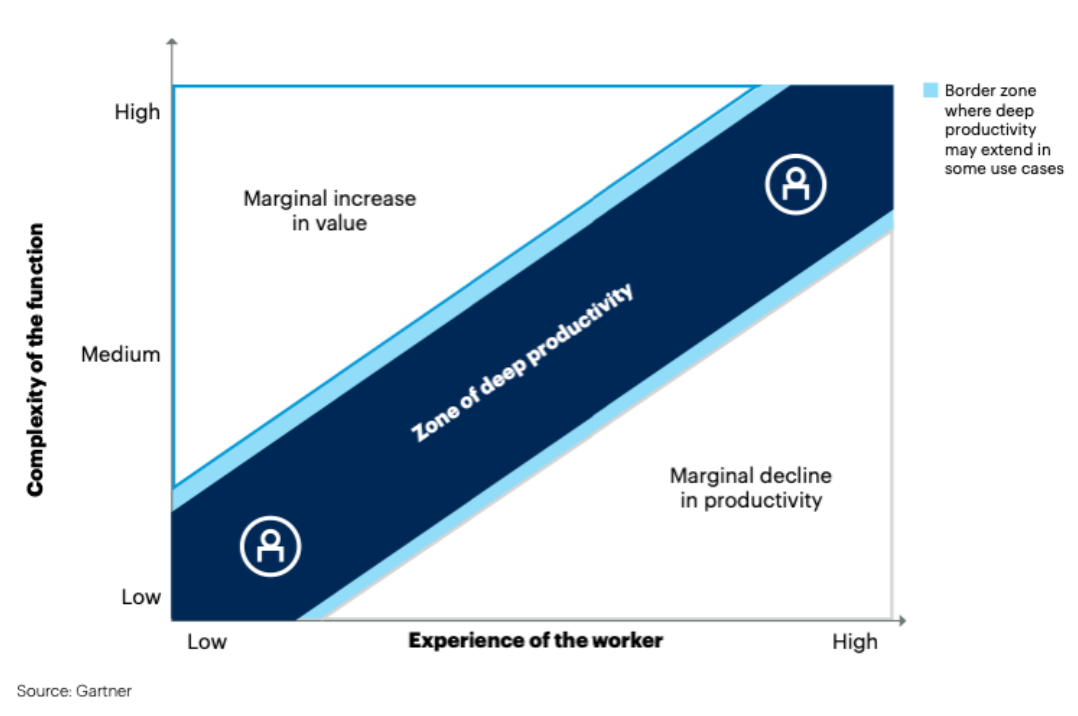Where AI Works Best: The Deep Productivity Zone
Not all AI use is smart, not all automation helps, and not every team is ready to plug in and magically become more productive. But here's what we do know: when AI is applied in the right place, at the right time, with the right people, it can unlock tremendous value.
Welcome to the Deep Productivity Zone.
The Truth About AI and Productivity
A recent Gartner study broke this wide open. Two people, same job, same AI tool—one thrives, one slows down. Why?
It comes down to two critical variables:
Experience of the worker
Complexity of the task
When these align correctly, AI can be transformational. That sweet spot is what Gartner calls the Deep Productivity Zone. It's where generative AI can compress learning curves, speed up decisions, and even make experienced employees more creative.
Imagine a new customer service rep who performs like a 6-month veteran within 8 weeks. Or a senior finance leader who uses AI not to replace thinking, but to think bigger, faster, and more strategically…That’s the zone.
Where AI Fails (Yes, Sometimes It Does)
Not everyone benefits. In fact, Gartner found that in low-complexity jobs, experienced workers can slow down when paired with AI, often because the tool interrupts their rhythm or overcomplicates simple work.
So before you roll out AI across your organization, stop and ask:
Who is this really for?
Are they early in their role and doing repeatable tasks?
Are they high-level experts solving complex problems?
If the answer is no to both, AI might not help them (yet). So, What Should You Do?
Here’s the playbook for Leaders:
Map your team: Chart roles by experience and task complexity. Use it like a heatmap to spot where AI will likely boost productivity—and where it might drag.
Start where the return is highest: Invest in AI tools for new hires in customer-facing roles or experienced pros in strategy-heavy functions. That’s where you’ll see the biggest wins.
Think beyond automation: AI isn’t just about doing the same work faster. It teaches, guides, and even sparks better decision-making in the deep zone. That’s the future.
Treat AI like a coworker, not a gadget: Coach your team on how to work with it. Ask: “What would you let your AI teammate handle so you can focus on the high-value work?”
Final Thought: It’s Not One-Size-Fits-All
The temptation is to chase the hype, deploy AI everywhere, cross your fingers, and hope it sticks. But productivity gains don’t come from blanket rollouts. They come from strategic fits. With the Third Workforce, your role as a leader isn’t just to adopt AI, it’s to orchestrate it. That means putting the right people in the right roles, with the right digital collaborators. That’s how you lead the future of work. You don’t need to automate everything; you simply need to design processes for the deep productivity zone.
ABOUT THE AUTHOR
Jeff Lupinacci spent the last 25 years at some of the world's best-known companies, such as Intel Corporation and Kimberly-Clark. His career spans key executive roles such as Chief Learning Officer, Chief Talent Officer, and Chief Integration Officer. After a successful corporate career, Jeff turned his focus to his true passion—serving the overworked and under-resourced HR profession.
Beyond his corporate success, Jeff is a sought-after speaker and thought leader, with his insights featured in leading publications such as CFO Europe, Nikkei Business Magazine, and Baylor Business Review. In addition to his business leadership, Jeff is an adjunct professor at Baylor University, where he teaches Human Capital Management for the Executive MBA program and leads the HR Strategy and Analytics capstone for undergraduates.
Jeff is the best-selling author of The Talent Advantage: A CEO’s Journey to Discover the Value of Talent. He lives in Dallas, Texas, with his wife and two doodles.


